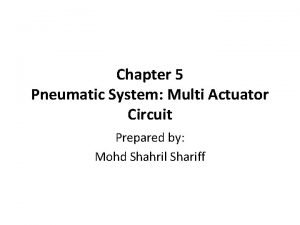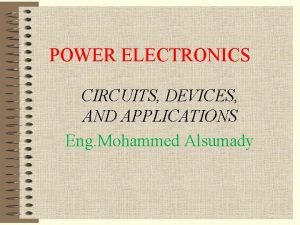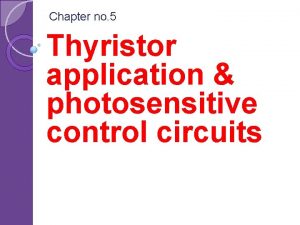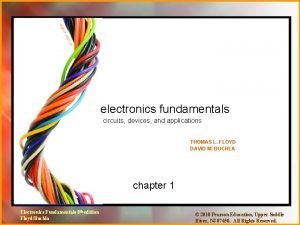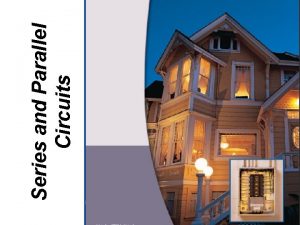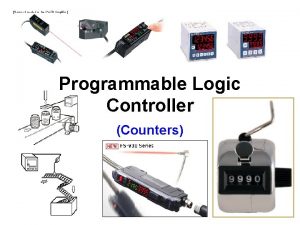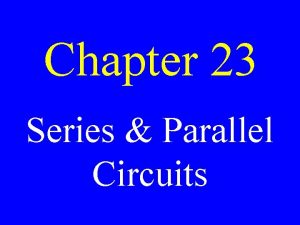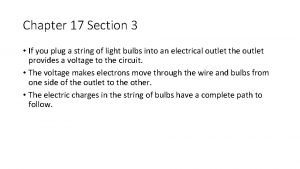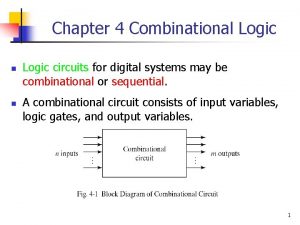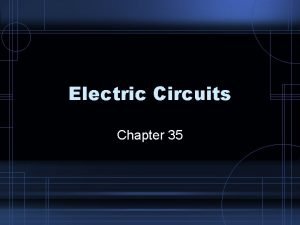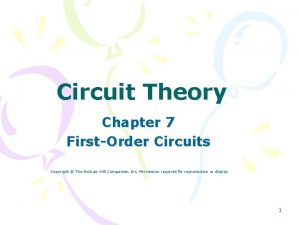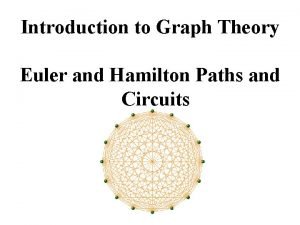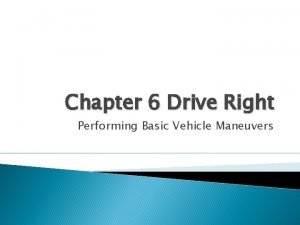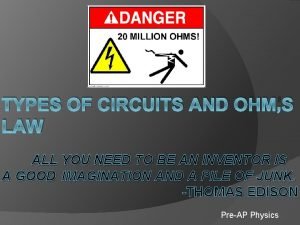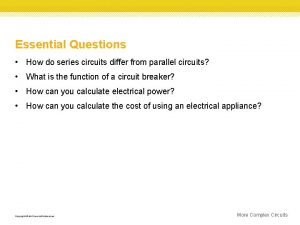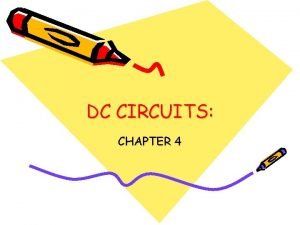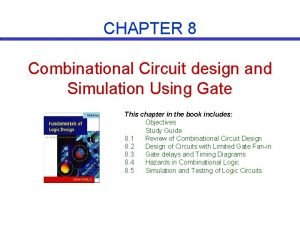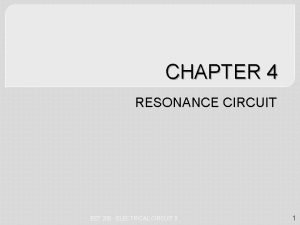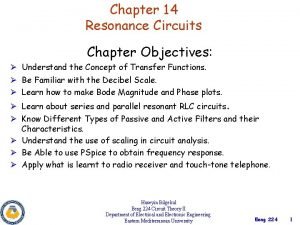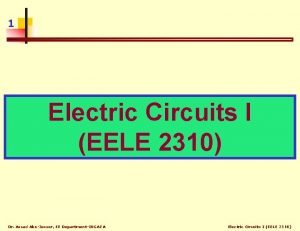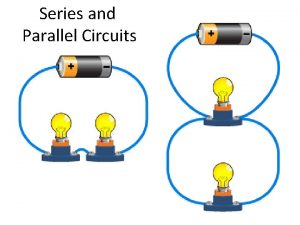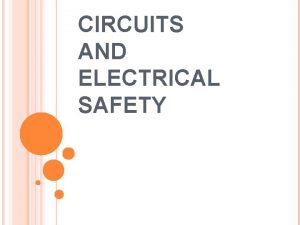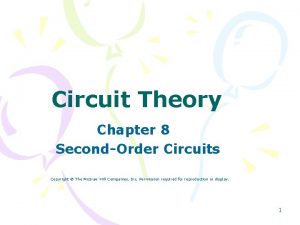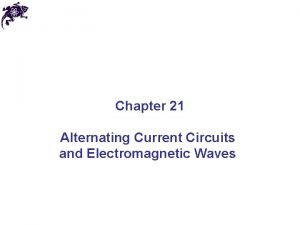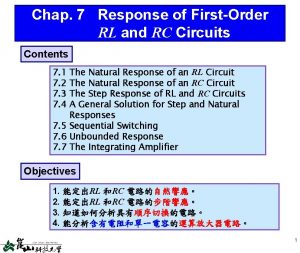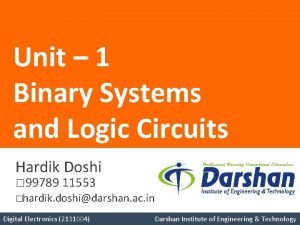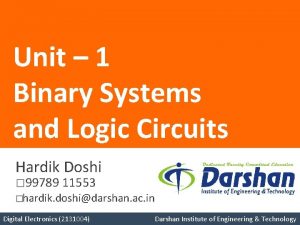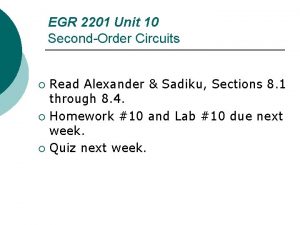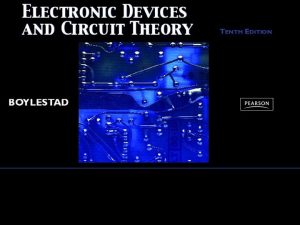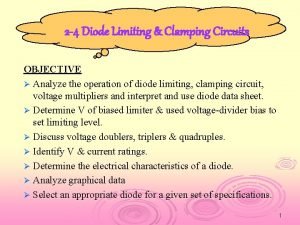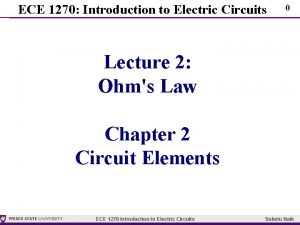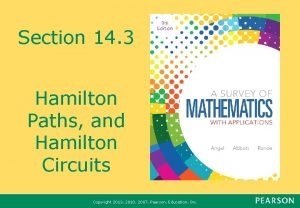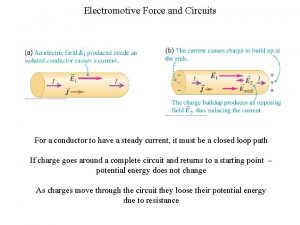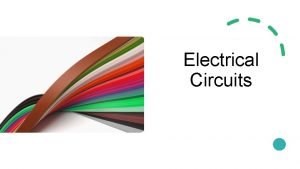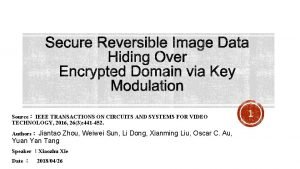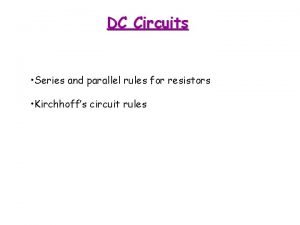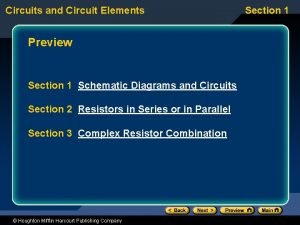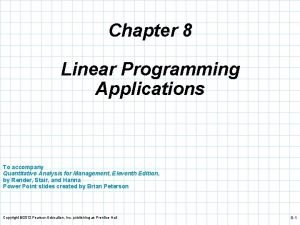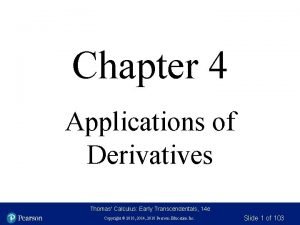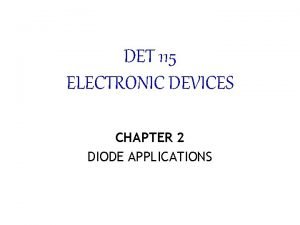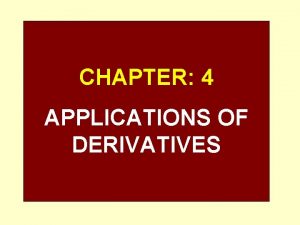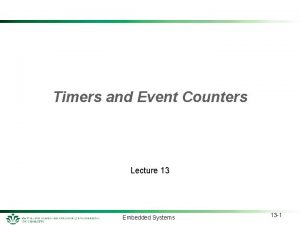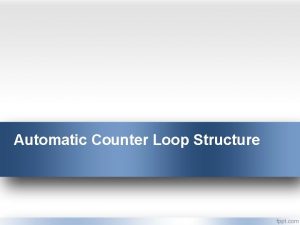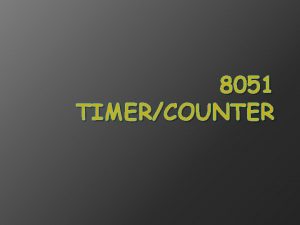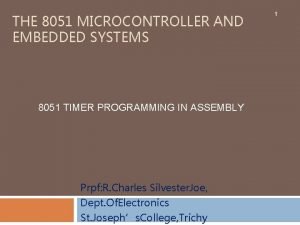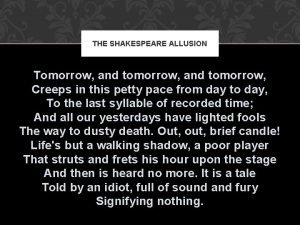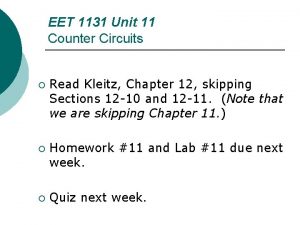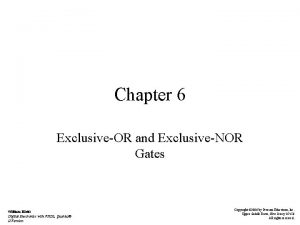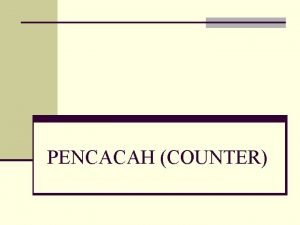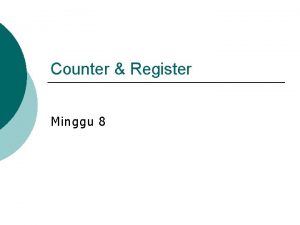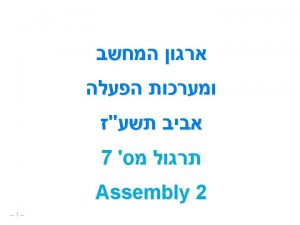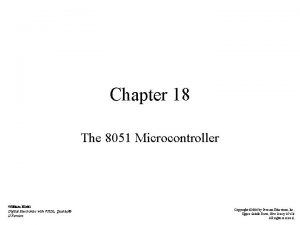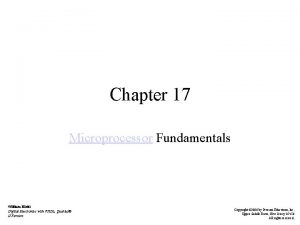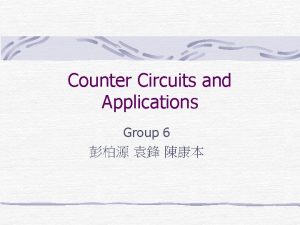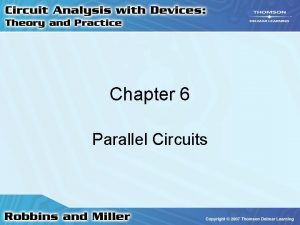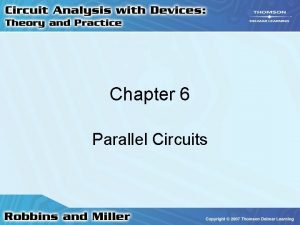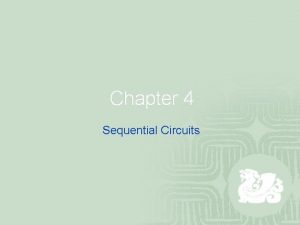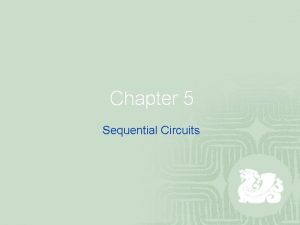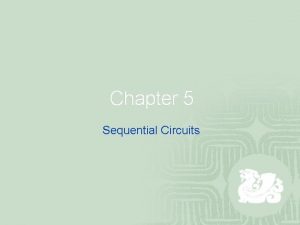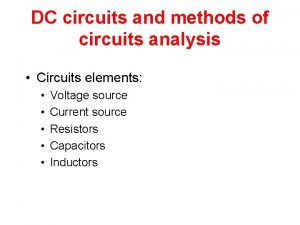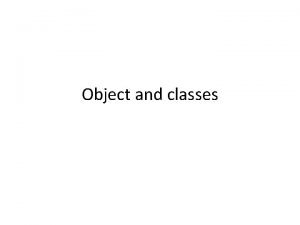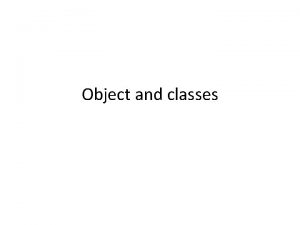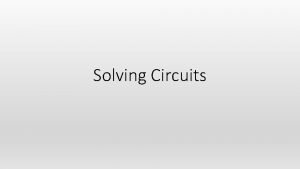Chapter 12 Counter Circuits and Applications William Kleitz














































































- Slides: 78

Chapter 12 Counter Circuits and Applications William Kleitz Digital Electronics with VHDL, Quartus® II Version Copyright © 2006 by Pearson Education, Inc. Upper Saddle River, New Jersey 07458 All rights reserved.

Analysis of Sequential Circuits • Mix of combinational logic gates and flipflops • See Examples 12 -1, 12 -2, 12 -3 and 12 -4 William Kleitz Digital Electronics with VHDL, Quartus® II Version Copyright © 2006 by Pearson Education, Inc. Upper Saddle River, New Jersey 07458 All rights reserved.

William Kleitz Digital Electronics with VHDL, Quartus® II Version Copyright © 2006 by Pearson Education, Inc. Upper Saddle River, New Jersey 07458 All rights reserved.

Solution: William Kleitz Digital Electronics with VHDL, Quartus® II Version Copyright © 2006 by Pearson Education, Inc. Upper Saddle River, New Jersey 07458 All rights reserved.

William Kleitz Digital Electronics with VHDL, Quartus® II Version Copyright © 2006 by Pearson Education, Inc. Upper Saddle River, New Jersey 07458 All rights reserved.

William Kleitz Digital Electronics with VHDL, Quartus® II Version Copyright © 2006 by Pearson Education, Inc. Upper Saddle River, New Jersey 07458 All rights reserved.

Solution: William Kleitz Digital Electronics with VHDL, Quartus® II Version Copyright © 2006 by Pearson Education, Inc. Upper Saddle River, New Jersey 07458 All rights reserved.

William Kleitz Digital Electronics with VHDL, Quartus® II Version Copyright © 2006 by Pearson Education, Inc. Upper Saddle River, New Jersey 07458 All rights reserved.

Ripple Counters: JK FFs and VHDL Description • Flip-flops used to form binary counters • Cascade one output to next input • Three flip-flops for a 3 -bit counter – 23 = 8 different combinations – 000 through 111 – modulus is 8 – MOD 8 counter William Kleitz Digital Electronics with VHDL, Quartus® II Version Copyright © 2006 by Pearson Education, Inc. Upper Saddle River, New Jersey 07458 All rights reserved.

Ripple Counters: JK FFs and VHDL Description • Use the toggle mode • See Figure 12 -9 • See Figure 12 -10 – waveforms – state diagram • Asynchronous counters William Kleitz Digital Electronics with VHDL, Quartus® II Version Copyright © 2006 by Pearson Education, Inc. Upper Saddle River, New Jersey 07458 All rights reserved.

Figure 12 -9 Figure 12 -10 William Kleitz Digital Electronics with VHDL, Quartus® II Version Copyright © 2006 by Pearson Education, Inc. Upper Saddle River, New Jersey 07458 All rights reserved.

Ripple Counters: JK FFs and VHDL Description • Propagation delay skews the waveform – See Figure 12 -11 • Maximum frequency is determined by reciprocal of the combination of propagation delays • MOD 16 counter – four flip-flops – See Figure 12 -12 and 12 -13 William Kleitz Digital Electronics with VHDL, Quartus® II Version Copyright © 2006 by Pearson Education, Inc. Upper Saddle River, New Jersey 07458 All rights reserved.

Figure 12 -11 William Kleitz Digital Electronics with VHDL, Quartus® II Version Copyright © 2006 by Pearson Education, Inc. Upper Saddle River, New Jersey 07458 All rights reserved.

Figure 12 -12 Figure 12 -13 William Kleitz Digital Electronics with VHDL, Quartus® II Version Copyright © 2006 by Pearson Education, Inc. Upper Saddle River, New Jersey 07458 All rights reserved.

Ripple Counters: JK FFs and VHDL Description • Down Counters – take binary outputs from the not-Q outputs – See Figure 12 -14 and 12 -15 William Kleitz Digital Electronics with VHDL, Quartus® II Version Copyright © 2006 by Pearson Education, Inc. Upper Saddle River, New Jersey 07458 All rights reserved.

Figure 12 -14 Figure 12 -15 William Kleitz Digital Electronics with VHDL, Quartus® II Version Copyright © 2006 by Pearson Education, Inc. Upper Saddle River, New Jersey 07458 All rights reserved.

Ripple Counters: JK FFs and VHDL Description • VHDL description of a Mod-16 up counter – VHDL description – simulation – see figure 12 -16 and 12 -17 William Kleitz Digital Electronics with VHDL, Quartus® II Version Copyright © 2006 by Pearson Education, Inc. Upper Saddle River, New Jersey 07458 All rights reserved.

Figure 12 -16 Figure 12 -17 William Kleitz Digital Electronics with VHDL, Quartus® II Version Copyright © 2006 by Pearson Education, Inc. Upper Saddle River, New Jersey 07458 All rights reserved.

Design of Divide-by-N Counters • Reduce the frequency of periodic waveforms – See Figure 12 -18 • Divide-by-5 (MOD 5) counter – See Figure 12 -19 – See Figure 12 -20 • waveforms • state diagram • Any modulus counter can be formed by using external gating William Kleitz Digital Electronics with VHDL, Quartus® II Version Copyright © 2006 by Pearson Education, Inc. Upper Saddle River, New Jersey 07458 All rights reserved.

Figure 12 -18 William Kleitz Digital Electronics with VHDL, Quartus® II Version Copyright © 2006 by Pearson Education, Inc. Upper Saddle River, New Jersey 07458 All rights reserved.

Figure 12 -19 Figure 12 -20 William Kleitz Digital Electronics with VHDL, Quartus® II Version Copyright © 2006 by Pearson Education, Inc. Upper Saddle River, New Jersey 07458 All rights reserved.

Ripple Counter Integrated Circuits • 7493 – 4 -bit binary ripple counter – See Figure 12 -31 - logic diagram – See Figure 12 -32 - MOD 16 ripple counter – See Figure 12 -33 - MOD 12 ripple counter • 7490 also used • 7492 also used William Kleitz Digital Electronics with VHDL, Quartus® II Version Copyright © 2006 by Pearson Education, Inc. Upper Saddle River, New Jersey 07458 All rights reserved.

Figure 12 -31 Figure 12 -32 William Kleitz Digital Electronics with VHDL, Quartus® II Version Copyright © 2006 by Pearson Education, Inc. Upper Saddle River, New Jersey 07458 All rights reserved.

Figure 12 -33 William Kleitz Digital Electronics with VHDL, Quartus® II Version Copyright © 2006 by Pearson Education, Inc. Upper Saddle River, New Jersey 07458 All rights reserved.

System Design Applications • LED illuminate for 1 s once every 13 s – See example 12 -16 • Turn on LED for 20 ms once every 100 ms – See Application 12 -17 • Three digit decimal counter 000 - 999 – See Application 12 -18 William Kleitz Digital Electronics with VHDL, Quartus® II Version Copyright © 2006 by Pearson Education, Inc. Upper Saddle River, New Jersey 07458 All rights reserved.

William Kleitz Digital Electronics with VHDL, Quartus® II Version Copyright © 2006 by Pearson Education, Inc. Upper Saddle River, New Jersey 07458 All rights reserved.

Figure 12 -39 William Kleitz Digital Electronics with VHDL, Quartus® II Version Copyright © 2006 by Pearson Education, Inc. Upper Saddle River, New Jersey 07458 All rights reserved.

William Kleitz Digital Electronics with VHDL, Quartus® II Version Copyright © 2006 by Pearson Education, Inc. Upper Saddle River, New Jersey 07458 All rights reserved.

William Kleitz Digital Electronics with VHDL, Quartus® II Version Copyright © 2006 by Pearson Education, Inc. Upper Saddle River, New Jersey 07458 All rights reserved.

System Design Applications • Digital clock capable of hours, min and sec – See example 12 -19 • Egg timer circuit – See example 12 -20 William Kleitz Digital Electronics with VHDL, Quartus® II Version Copyright © 2006 by Pearson Education, Inc. Upper Saddle River, New Jersey 07458 All rights reserved.

William Kleitz Digital Electronics with VHDL, Quartus® II Version Copyright © 2006 by Pearson Education, Inc. Upper Saddle River, New Jersey 07458 All rights reserved.

Figure 12 -42 William Kleitz Digital Electronics with VHDL, Quartus® II Version Copyright © 2006 by Pearson Education, Inc. Upper Saddle River, New Jersey 07458 All rights reserved.

William Kleitz Digital Electronics with VHDL, Quartus® II Version Copyright © 2006 by Pearson Education, Inc. Upper Saddle River, New Jersey 07458 All rights reserved.

Figure 12 -43 William Kleitz Digital Electronics with VHDL, Quartus® II Version Copyright © 2006 by Pearson Education, Inc. Upper Saddle River, New Jersey 07458 All rights reserved.

Seven-Segment LED Display Decoders: The 7447 IC and VHDL Description • Counters must output BCD • Common-Anode LED Display – See Figure 12 -44 • physical layout • schematic • pin configuration – driver needs active-LOW outputs • Common-Cathode LED Display – needs active-HIGH output - not common William Kleitz Digital Electronics with VHDL, Quartus® II Version Copyright © 2006 by Pearson Education, Inc. Upper Saddle River, New Jersey 07458 All rights reserved.

Figure 12 -44 William Kleitz Digital Electronics with VHDL, Quartus® II Version Copyright © 2006 by Pearson Education, Inc. Upper Saddle River, New Jersey 07458 All rights reserved.

Seven-Segment LED Display Decoders: The 7447 IC and VHDL Description • BCD-to-Seven-Segment Decoder/Driver ICs • 7447 – 4 -bit BCD input – seven active-LOW outputs – lamp test input – ripple blanking input and output – See Figure 12 -47 – See Figure 12 -48 William Kleitz Digital Electronics with VHDL, Quartus® II Version Copyright © 2006 by Pearson Education, Inc. Upper Saddle River, New Jersey 07458 All rights reserved.

Figure 12 -47 Figure 12 -48 William Kleitz Digital Electronics with VHDL, Quartus® II Version Copyright © 2006 by Pearson Education, Inc. Upper Saddle River, New Jersey 07458 All rights reserved.

Seven-Segment LED Display Decoders: The 7447 IC and VHDL Description • Driving a Multiplexed Display with a Microcontroller – to save power – not all displays on at once – See Figure 12 -50 William Kleitz Digital Electronics with VHDL, Quartus® II Version Copyright © 2006 by Pearson Education, Inc. Upper Saddle River, New Jersey 07458 All rights reserved.

Figure 12 -50 William Kleitz Digital Electronics with VHDL, Quartus® II Version Copyright © 2006 by Pearson Education, Inc. Upper Saddle River, New Jersey 07458 All rights reserved.

Seven-Segment LED Display Decoders: The 7447 IC and VHDL Description • VHDL description of the seven segment decoder – 7447 decoding features in VHDL – truth table – see table 12 -2 – see figure 12 -51 – see figure 12 -52 William Kleitz Digital Electronics with VHDL, Quartus® II Version Copyright © 2006 by Pearson Education, Inc. Upper Saddle River, New Jersey 07458 All rights reserved.

William Kleitz Digital Electronics with VHDL, Quartus® II Version Copyright © 2006 by Pearson Education, Inc. Upper Saddle River, New Jersey 07458 All rights reserved.

Figure 12 -51 Figure 12 -52 William Kleitz Digital Electronics with VHDL, Quartus® II Version Copyright © 2006 by Pearson Education, Inc. Upper Saddle River, New Jersey 07458 All rights reserved.

Synchronous Counters • All clock inputs tied to common clock line • 4 -bit synchronous counter – MOD 16 counter – 4 flip-flops – See Figure 12 -53 William Kleitz Digital Electronics with VHDL, Quartus® II Version Copyright © 2006 by Pearson Education, Inc. Upper Saddle River, New Jersey 07458 All rights reserved.

Figure 12 -53 William Kleitz Digital Electronics with VHDL, Quartus® II Version Copyright © 2006 by Pearson Education, Inc. Upper Saddle River, New Jersey 07458 All rights reserved.

Synchronous Up/Down Counter ICs • 74192 and 74193 – 74192 - decade counter – 74193 - binary counter – See Figure 12 -56 - logic symbol – two clock inputs (up and down) – terminal count outputs - when max is reached – Function Table • See Table 12 -3 William Kleitz Digital Electronics with VHDL, Quartus® II Version Copyright © 2006 by Pearson Education, Inc. Upper Saddle River, New Jersey 07458 All rights reserved.

Figure 12 -56 William Kleitz Digital Electronics with VHDL, Quartus® II Version Copyright © 2006 by Pearson Education, Inc. Upper Saddle River, New Jersey 07458 All rights reserved.

William Kleitz Digital Electronics with VHDL, Quartus® II Version Copyright © 2006 by Pearson Education, Inc. Upper Saddle River, New Jersey 07458 All rights reserved.

Synchronous Up/Down Counter ICs • 74190 and 74191 – 74190 - BCD counter – 74191 - 4 -bit counter – See Figure 12 -61 - logic symbol – parallel load - preset counter – U/D - select up or down counting – terminal count output when max reached – ripple clock output for cascading William Kleitz Digital Electronics with VHDL, Quartus® II Version Copyright © 2006 by Pearson Education, Inc. Upper Saddle River, New Jersey 07458 All rights reserved.

Figure 12 -61 William Kleitz Digital Electronics with VHDL, Quartus® II Version Copyright © 2006 by Pearson Education, Inc. Upper Saddle River, New Jersey 07458 All rights reserved.

Synchronous Up/Down Counter ICs • 74160/61/62/63 – count enable inputs – terminal count output – See Figure 12 -63 - logic symbol William Kleitz Digital Electronics with VHDL, Quartus® II Version Copyright © 2006 by Pearson Education, Inc. Upper Saddle River, New Jersey 07458 All rights reserved.

Figure 12 -63 William Kleitz Digital Electronics with VHDL, Quartus® II Version Copyright © 2006 by Pearson Education, Inc. Upper Saddle River, New Jersey 07458 All rights reserved.

Applications of Synchronous Counter ICs • Count 0 to 9, 9 to 0 and 0 to 9 – See example 12 -26 • Divide-by-9 frequency divider using 74193 – See example 12 -27 • Divide-by-200 using synchronous counters – See example 12 -28 • MOD 7 synchronous up-counter using 74163 – See example 12 -29 William Kleitz Digital Electronics with VHDL, Quartus® II Version Copyright © 2006 by Pearson Education, Inc. Upper Saddle River, New Jersey 07458 All rights reserved.

William Kleitz Digital Electronics with VHDL, Quartus® II Version Copyright © 2006 by Pearson Education, Inc. Upper Saddle River, New Jersey 07458 All rights reserved.

William Kleitz Digital Electronics with VHDL, Quartus® II Version Copyright © 2006 by Pearson Education, Inc. Upper Saddle River, New Jersey 07458 All rights reserved.

William Kleitz Digital Electronics with VHDL, Quartus® II Version Copyright © 2006 by Pearson Education, Inc. Upper Saddle River, New Jersey 07458 All rights reserved.

William Kleitz Digital Electronics with VHDL, Quartus® II Version Copyright © 2006 by Pearson Education, Inc. Upper Saddle River, New Jersey 07458 All rights reserved.

VHDL and LPM Counters • VHDL up-counter – 4 bit – asynchronous reset – parallel load – similar to 74193 • See figure 12 -69 and 12 -70 William Kleitz Digital Electronics with VHDL, Quartus® II Version Copyright © 2006 by Pearson Education, Inc. Upper Saddle River, New Jersey 07458 All rights reserved.

Figure 12 -69 Figure 12 -70 William Kleitz Digital Electronics with VHDL, Quartus® II Version Copyright © 2006 by Pearson Education, Inc. Upper Saddle River, New Jersey 07458 All rights reserved.

VHDL and LPM Counters • VHDL up-down counter • see figure 12 -71 • A flow chart is helpful in describing a program with many IF-ELSE and ELSIF statements – see figure 12 -72 William Kleitz Digital Electronics with VHDL, Quartus® II Version Copyright © 2006 by Pearson Education, Inc. Upper Saddle River, New Jersey 07458 All rights reserved.

Figure 12 -71 William Kleitz Digital Electronics with VHDL, Quartus® II Version Copyright © 2006 by Pearson Education, Inc. Upper Saddle River, New Jersey 07458 All rights reserved.

Figure 12 -72 William Kleitz Digital Electronics with VHDL, Quartus® II Version Copyright © 2006 by Pearson Education, Inc. Upper Saddle River, New Jersey 07458 All rights reserved.

VHDL and LPM Counters • LPM counter – pre-defined counter LPM_COUNTER • synchronous and asynchronous inputs • specify LPM_WIDTH and LPM_MODULUS – LPM up/down counter with asynchronous set and clear and a count enable William Kleitz Digital Electronics with VHDL, Quartus® II Version Copyright © 2006 by Pearson Education, Inc. Upper Saddle River, New Jersey 07458 All rights reserved.

Implementing State Machines in VHDL • Outputs of a state machine are triggered by a clock and other input stimulus • VHDL implementation of a state machine – define the sequence of output states – step through the states in a numerical order, or – step through the states in an order determined by one or more control inputs William Kleitz Digital Electronics with VHDL, Quartus® II Version Copyright © 2006 by Pearson Education, Inc. Upper Saddle River, New Jersey 07458 All rights reserved.

Implementing State Machines in VHDL • A gray code sequencer in VHDL and the simulation – see figure 12 -76 – see figure 12 -77 William Kleitz Digital Electronics with VHDL, Quartus® II Version Copyright © 2006 by Pearson Education, Inc. Upper Saddle River, New Jersey 07458 All rights reserved.

Figure 12 -76 William Kleitz Digital Electronics with VHDL, Quartus® II Version Copyright © 2006 by Pearson Education, Inc. Upper Saddle River, New Jersey 07458 All rights reserved.

Figure 12 -77 William Kleitz Digital Electronics with VHDL, Quartus® II Version Copyright © 2006 by Pearson Education, Inc. Upper Saddle River, New Jersey 07458 All rights reserved.

Implementing State Machines in VHDL • State machine design are commonly used in stepper motor control – stepper motor operation – present state and next state – stepper motor state diagram • see figure 12 -78 – 4 bit stepper motor sequencer and simulation • see figure 12 -79 and 12 -80 William Kleitz Digital Electronics with VHDL, Quartus® II Version Copyright © 2006 by Pearson Education, Inc. Upper Saddle River, New Jersey 07458 All rights reserved.

Figure 12 -79 William Kleitz Digital Electronics with VHDL, Quartus® II Version Copyright © 2006 by Pearson Education, Inc. Upper Saddle River, New Jersey 07458 All rights reserved.

Figure 12 -80 William Kleitz Digital Electronics with VHDL, Quartus® II Version Copyright © 2006 by Pearson Education, Inc. Upper Saddle River, New Jersey 07458 All rights reserved.

Implementing State Machines in VHDL • State machines with multiple control inputs – control (handshake) signals between peripherals and the microprocessor • read, write, ready to receive, ready to transmit, buffer full, end of transmit, and parity error • 8 bit Analog to digital converter (ADC) operation – the ADC in VHDL William Kleitz Digital Electronics with VHDL, Quartus® II Version Copyright © 2006 by Pearson Education, Inc. Upper Saddle River, New Jersey 07458 All rights reserved.

Summary • Toggle flip-flops can be cascaded end to form ripple counters. • Ripple counters cannot be used in highspeed circuits because of the problem they have with the accumulation of propagation delay through all the flip-flops. • A down counter can be built by taking the outputs from the not-Q’s of a ripple counter. William Kleitz Digital Electronics with VHDL, Quartus® II Version Copyright © 2006 by Pearson Education, Inc. Upper Saddle River, New Jersey 07458 All rights reserved.

Summary • Any modulus (or divide-by) counter can be formed by resetting the basic ripple counter when a specific count is reached. • A glitch is a short-duration pulse that may appear on some of the output bits of a counter. William Kleitz Digital Electronics with VHDL, Quartus® II Version Copyright © 2006 by Pearson Education, Inc. Upper Saddle River, New Jersey 07458 All rights reserved.

Summary • Ripple counter ICs such as the 7490, 7492, and 7493 have four flip-flops integrated into a single package providing four-bit counter operations. • Four-bit counter ICs can be cascaded end to form counters with higher than MOD 16 capability. William Kleitz Digital Electronics with VHDL, Quartus® II Version Copyright © 2006 by Pearson Education, Inc. Upper Saddle River, New Jersey 07458 All rights reserved.

Summary • Seven-segment LED displays choose between seven separate LEDs (plus a decimal point LED) to form the 10 decimal digits. They are constructed with either the anodes or the cathodes connected to a common pin. William Kleitz Digital Electronics with VHDL, Quartus® II Version Copyright © 2006 by Pearson Education, Inc. Upper Saddle River, New Jersey 07458 All rights reserved.

Summary • LED displays require a decoder/driver IC such as the 7447 to decode BCD data into a seven-bit code to activate the appropriate segments to illuminate the correct digit. • Synchronous counters eliminate the problem of accumulated propagation delay associated with ripple counters by driving all four flip-flops with a common clock. William Kleitz Digital Electronics with VHDL, Quartus® II Version Copyright © 2006 by Pearson Education, Inc. Upper Saddle River, New Jersey 07458 All rights reserved.

Summary • The 74192 and 74193 are 4 -bit synchronous counter ICs. They have a count-up/countdown feature and can accept a 4 -bit parallel load of binary data. • The 74190 and 74191 synchronous counter ICs are similar to the 74192/74193 except they are better for constructing multistage counters of more than 4 bits. William Kleitz Digital Electronics with VHDL, Quartus® II Version Copyright © 2006 by Pearson Education, Inc. Upper Saddle River, New Jersey 07458 All rights reserved.

Summary • VHDL can be used to implement Mod-n counters. • A seven segment decoder can be effectively described in VHDL. • The library of parameterized modules provides an LPM counter that can be customized to perform many counting tasks. • State Machines can be implemented in VHDL. William Kleitz Digital Electronics with VHDL, Quartus® II Version Copyright © 2006 by Pearson Education, Inc. Upper Saddle River, New Jersey 07458 All rights reserved.
 Current in a parallel circuit
Current in a parallel circuit A+b+b-a- pneumatic circuit
A+b+b-a- pneumatic circuit Power electronics circuits devices and applications
Power electronics circuits devices and applications Thyristor applications and circuits
Thyristor applications and circuits Electronics fundamentals circuits devices and applications
Electronics fundamentals circuits devices and applications Applications of series circuits
Applications of series circuits Circuits
Circuits Apple conveyor ladder diagram
Apple conveyor ladder diagram Chapter 23 series and parallel circuits answers
Chapter 23 series and parallel circuits answers Fundamentals of electric circuits chapter 4 solutions
Fundamentals of electric circuits chapter 4 solutions Chapter 20 electric circuits
Chapter 20 electric circuits Conceptual physics chapter 35
Conceptual physics chapter 35 Chapter 20 electric circuits
Chapter 20 electric circuits Chapter 17 section 3 circuits answer key
Chapter 17 section 3 circuits answer key Fundamentals of electric circuits chapter 9 solutions
Fundamentals of electric circuits chapter 9 solutions Fundamentals of electric circuits chapter 7 solutions
Fundamentals of electric circuits chapter 7 solutions Chapter 35 electric circuits answers
Chapter 35 electric circuits answers Ohm's law calculations worksheet
Ohm's law calculations worksheet For a three variable combinational circuits, m(1,4,7)=
For a three variable combinational circuits, m(1,4,7)= Chapter 35 electric circuits
Chapter 35 electric circuits First order circuit
First order circuit Euler circuit
Euler circuit A hamilton circuit
A hamilton circuit Pros and cons of series circuits
Pros and cons of series circuits Skills and applications chapter 3
Skills and applications chapter 3 Chapter 6 basic maneuvers
Chapter 6 basic maneuvers Chapter 28 unemployment
Chapter 28 unemployment The life skill using community resources means
The life skill using community resources means Difference between datagram and virtual circuit network
Difference between datagram and virtual circuit network Types of circuits and ohm's law
Types of circuits and ohm's law An incomplete circuit
An incomplete circuit Difference between series and parallel circuits
Difference between series and parallel circuits How do series and parallel circuits differ
How do series and parallel circuits differ Capacitor in dc circuit
Capacitor in dc circuit Simulation and testing of logic circuits
Simulation and testing of logic circuits Parallel circuit characteristics
Parallel circuit characteristics Parallel resonance
Parallel resonance Lesson 8: comparing series and parallel rlc circuits
Lesson 8: comparing series and parallel rlc circuits Facts about series and parallel circuits
Facts about series and parallel circuits James w nilsson
James w nilsson Bill nye current electricity
Bill nye current electricity Venn diagram of heat and electricity
Venn diagram of heat and electricity Venn diagram series and parallel circuits
Venn diagram series and parallel circuits V r and i in parallel circuits ch.8:1 answer key
V r and i in parallel circuits ch.8:1 answer key Alternating current circuits and electromagnetic waves
Alternating current circuits and electromagnetic waves Response of first-order rl and rc circuits
Response of first-order rl and rc circuits 2057 octal to decimal
2057 octal to decimal Binary systems and logic circuits
Binary systems and logic circuits Mealy and moore sequential circuits
Mealy and moore sequential circuits First and second order circuits
First and second order circuits Feedback and oscillator circuits
Feedback and oscillator circuits Limiting and clamping circuits
Limiting and clamping circuits Valid and invalid circuits
Valid and invalid circuits Sec 7.4 hamilton circuits and paths
Sec 7.4 hamilton circuits and paths Thevenin and norton equivalent circuits
Thevenin and norton equivalent circuits Electromotive force and circuits
Electromotive force and circuits Complete and incomplete circuit
Complete and incomplete circuit Transactions on circuits and systems
Transactions on circuits and systems Series circuit rules
Series circuit rules Circuits and circuit elements
Circuits and circuit elements Analogy between electric and magnetic circuits
Analogy between electric and magnetic circuits Chapter 23:3 administering heat/cold applications
Chapter 23:3 administering heat/cold applications Chapter 8 linear programming applications solutions
Chapter 8 linear programming applications solutions Chapter 4 applications of derivatives
Chapter 4 applications of derivatives Chapter 2: diode applications solutions
Chapter 2: diode applications solutions Chapter 4 applications of derivatives
Chapter 4 applications of derivatives Software timer in embedded system
Software timer in embedded system Concession/rebuttal
Concession/rebuttal Parts of a bar top
Parts of a bar top Flowchart loop counter
Flowchart loop counter The 8051 has______16-bit counter/timers
The 8051 has______16-bit counter/timers What is a counterclaim in writing example
What is a counterclaim in writing example Tmod register
Tmod register What is counterclaim in writing
What is counterclaim in writing Primary restraint technique
Primary restraint technique Application of heat transfer
Application of heat transfer Fuzzy sets and fuzzy logic theory and applications
Fuzzy sets and fuzzy logic theory and applications Tomorrow and tomorrow and tomorrow creeps
Tomorrow and tomorrow and tomorrow creeps Lesson outline lesson 3 describing circuits answers
Lesson outline lesson 3 describing circuits answers

